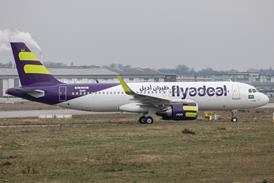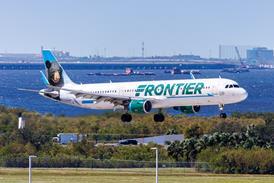PAUL LEWIS / NAS PATUXENT RIVER
US Navy's Super Hornet lead squadron cleared for first operational cruise next June
The US Navy is working towards the first operational BoeingF/A-18E/F Super Hornet deployment as the programme office outlines its plans for broadening the new fighter's weapon, sensor and self-defence capabilities.
The lead F/A-18E squadron, VFA-115, has been declared "safe for flight", clearing it for the first operational cruise next June aboard USS Abraham Lincoln. The first two-seat F/A-18F squadron, VFA-41, will go to sea in 2003, which will also mark the operational debut of the Raytheon ATFLIR targeting pod.
"ATFLIR will have four times the resolution of the Hornet's Lockheed Martin Nite Hawk system and twice that of [Lockheed Martin] LANTIRN," says Capt Jeffrey Wieringa, USN F/A-18 programme manager. "We have a marked improvement in reliability already with twice the meantime between operational failure."
Initially, Super Hornet has been cleared to carry the Boeing GBU-31 JDAM and Raytheon AGM-154 JSOWGPS-satellite navigation-guided precision munitions and Raytheon AIM-120 AMRAAM air-to-air missile. Flight testing of the VSI Joint Helmet Mounted Cueing System and Raytheon Sharp reconnaissance pod on the F/A-18E/F has now started. First deliveries are due in FY2003.
Also in the FY03 pipeline is the first advanced mission computer and display-equipped Super Hornet, with the advanced crew station following in FY05. The final Block 3 version of the Integrated Defensive Electronic Countermeasures System - equipped with BAE Systems' ALE-55 fibre-optic towed decoy and ITT ALQ-214 jammer - is due for delivery in FY04.
Raytheon, meanwhile, has started the critical design review of the Super Hornet's active electronically scanned array (AESA) radar, with first flight scheduled for 2003. The radar will be delivered in 2007, midway through the second multi-year procurement of F/A-18E/Fs. Earlier build aircraft will have provision for the radar, but the final number of retrofits has not been decided, says Wieringa.
Based on the planned procurement of 204 F/A-18Es and 244 F/A-18Fs, the USN is planning to equip each carrier air wing with 12 single and 14 two-seat fighters. This will include four or five aircraft configured for in-flight refuelling equipped with a centreline hose drum unit and up to four 1,800-litre (480USgal) underwing tanks.
Source: Flight International























